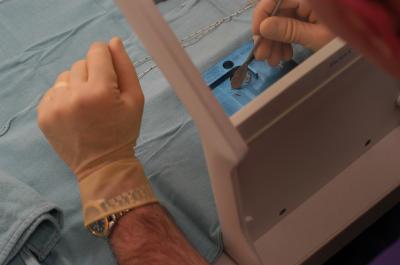November 4, 2004
New type of radioactive seeds used to treat prostate cancer
In the first significant advancement in brachytherapy in more than 15 years, physicians at UW Medical Center last week implanted for the first time in the world a new type of radioactive seeds in a prostate cancer patient.
The cesium-131 (Cs-131) brachytherapy implant seeds, developed by IsoRay of Richland, Wash., provides another viable option for men with prostate cancer, said Dr. Leroy Korb, UW assistant professor of radiation oncology.
“The Cs-131 seed developed by IsoRay offers a shorter half-life and faster delivery of the total radiation dose than the other types of seeds currently on the market,” Korb said. “We believe it will be an effective option for men choosing brachytherapy to treat their prostate cancer.”
The Cs-131 seed has a half-life of 9.7 days, compared to 60 days for iodine-125 seeds. It delivers more than 90 percent of its total radiation dose in less than 33 days.
“The new Cs-131 seed has a significantly higher dose rate than iodine, allowing for the delivery of more radiation in a shorter period of time to maximize its effectiveness,” Korb said. “The treatment is over in one-sixth the time of iodine seeds and leaves the body 500 days faster.”
Korb and Dr. William Ellis, professor of urology, implanted the first Cs-131 seeds in a 74-year-old Brookings, Ore., man in a procedure in UW Medical Center’s new Surgery Pavilion. The procedure was completed in 45 to 60 minutes. Needles are used to implant the seeds, which are smaller than a grain of rice. No incision or suturing is required, and the patient usually doesn’t need to stay overnight.
The patient is usually back to his normal work and daily activities within two to three days. After about three months, doctors will check to measure the effectiveness of the treatment.
Due to the shorter duration of treatment with Cs-131, side effects such as incontinence, urinary urgency or pain may be lessened, Korb said. Men who had good erectile function prior the implant should not experience any problems following the procedure.
Prostate cancer is one of the leading causes of death among men. About 230,000 men will be diagnosed with prostate cancer this year in the United States, and about 40,000 will die of the disease.
Ellis said that among patients in the UW prostate cancer program, about 50 percent have chosen surgery and the other 50 percent have chosen radiation treatment. Of the group that chose radiation, about 30 percent had external beam radiation and 20 percent had implanted seeds.
“We are very pleased to be the first to offer this new type of treatment at UW Medical Center and to partner with IsoRay, a Washington-based company,” Korb said.

